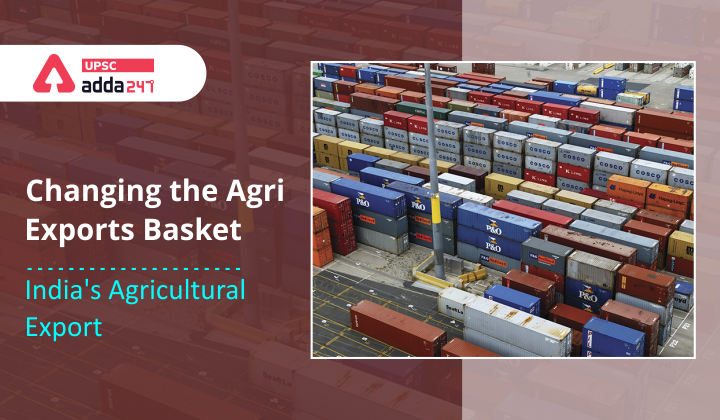Table of Contents
India’s Agricultural Export- Relevance for UPSC Exam
- GS Paper 3: Indian Agriculture- Transport and marketing of agricultural produce and issues and related constraints.
- Food processing and related industries in India- scope and significance, location, upstream and downstream requirements, supply chain management.
Get free video for UPSC CSE preparation and make your dream of becoming an IAS/IPS/IRS a reality
India’s Agricultural Export- Background
- India has the potential to become a global leader in the food processing sector. The Indian government has been encouraging agricultural exports to meet an ambitious target of $60bn by 2022.
- Present status: From 2015-16 to 2019-20, the value of agricultural and processed food increased significantly from $17.8bn to $20.65bn.
FSSAI’s State Food Safety Index 2021
India’s Agricultural Export- Changing Agri Exports Basket
- A shift from primary to secondary agriculture: where focus is on developing various processed foods.
- The Indian food processing industry promises high economic growth and makes good profits.
- Change in India’s Agri-export basket: There have been many changes for example-
- From basmati rice to the export of non-basmati rice: In 2020-21, India exported 13.09 million tonnes of non-basmati rice ($4.8bn), up from an average 6.9 million tonnes ($2.7bn) in the previous five years.
- Strong demand for Indian Buffalo meat in recent years: especially in countries like Vietnam, Hong Kong, and Indonesia.
- In 2020-21, the export of poultry, sheep and goat meat, cashew kernels, groundnuts, guar gum, and cocoa products went down in terms of value and total quantity.
UN Glasgow Climate Change Conference (COP 26)
India’s Agricultural Export- Challenges faced by Agri-Exporters
- Low contribution in India’s total exports: Ministry of Food Processing Industries shows that the contribution of agricultural and processed food products in India’s total exports is 11%.
- India’s Agri-export is majorly dominated by Primary processed agricultural commodities.
- Difficulty faced by Indian processed food exporters: some of them are listed below-
- Non-tariff measures are imposed by other countries on Indian exports.
- Mandatory pre-shipment examination by the Export Inspection Agency being lengthy and costly;
- Compulsory spice board certification being needed even for ready-to-eat products which contain spices in small quantities;
- Lack of strategic planning of exports by most State;
- Lack of a predictable and consistent agricultural policy discouraging investments by the private sector;
- Prohibition of import of meat- and dairy based-products in most of the developed countries;
- Withdrawal of the Generalized System of Preference by the U.S. for import of processed food from India;
- Export shipments to the U.S. requiring an additional health certificate; and
- The absence of an equivalency agreement with developed countries for organic produce.
India’s Agricultural Export- Way Forwards
- Increasing share of Agricultural export in total exports: This can be done by focusing more on value-added processed food products rather than primary processed agricultural commodities.
- Redefine the Agriculture Export Policy: The main objective of the policy is to diversify and expand the export basket so that instead of primary products, the export of higher value items, including perishables and processed food, be increased. The Centre government should–
- Nurture food processing companies,
- Ensure low cost of production and global food quality standards, and
- Create a supportive environment to promote the export of processed food.
- Promoting Processed food: Reputed Indian brands should be encouraged to export processed foods globally as they can comply with the global standard of the codex.
- Indian companies should focus on cost competitiveness, global food quality standards, technology, and tap the global processed food export market.
- India has competitive advantages in various agricultural commodities which can be passed onto processed foods.




 TSPSC Group 1 Question Paper 2024, Downl...
TSPSC Group 1 Question Paper 2024, Downl...
 TSPSC Group 1 Answer key 2024 Out, Downl...
TSPSC Group 1 Answer key 2024 Out, Downl...
 UPSC Prelims 2024 Question Paper, Downlo...
UPSC Prelims 2024 Question Paper, Downlo...





